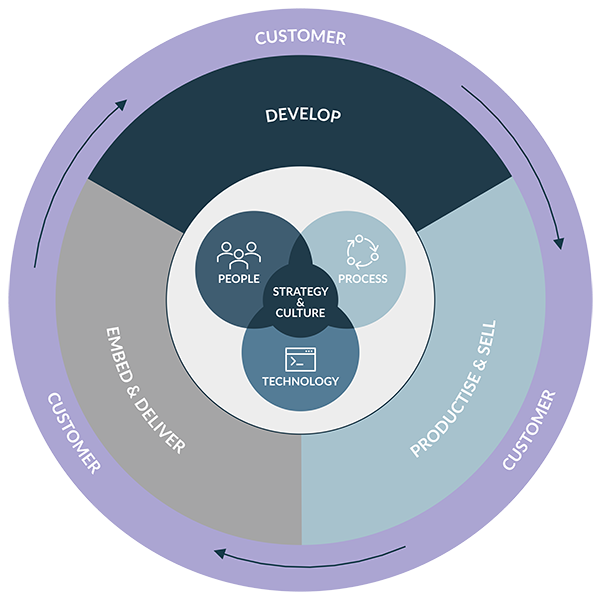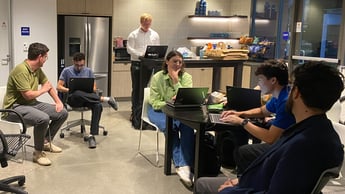Digital Service Development
Can you survive in today’s competitive market by “just” making a great machine for your customer? We see a trend with all our customers in the manufacturing world where the answer to this question is: no.
We need to build additional services on top of the machine to make it more efficient, effective, or even to change the way it is being used. We need to design digital services, that use the data from the machine, algorithms, AI techniques, and software. Digital services, that move the needle from “automated handling” to “automated thinking”.
The success of such a digital service depends on one 'simple' thing: the added value to your customer and your customer's customer. Gaining efficiency and making a profitable business out of it. Those are some of the ingredients, and although this may sound easy, this is harder than you realize at first.
Some perspective
Before looking forward and defining how to accelerate digital service development, it helps to take a step back and acknowledge where you are coming from. By looking back, you’ll come to the realization that you have been developing digital services for over 25 years. Most services started in B2C. Think of services like Hotmail and ICQ. The first online stores like Amazon and Bol.com. Voting for candidates to win in talent shows on television, while sitting at home on the couch.
What we can learn from that is the efficiency of scale. That is what made these services successful - build once, sell many; create standard functionality that is appreciated by many customers who are willing to pay for it.
The second thing we can learn looking back is that available technology drives the digital service development. And the more technology evolves, and costs go down, the more use cases become beneficial to automate. Think of predictive maintenance services where we are automating observations and thinking.
Last but not least it’s good to realize technology will further evolve while moving forward, making digital service development a journey.
Where are we today
Fast forward to the present. Whether you are a large enterprise or small company: we all face the same challenges and struggles. Technology is there. Connectivity is there. We are innovating, we are developing new digital services.
But in B2B, the struggle is even bigger to turn those into complete, professional, profitable services. What will be our new business models, how to make a profitable business out of it? If we want to continue and accelerate digital service development (which we do) it is key that we have paying customers, it’s that simple.
The complex part: digital service development has many aspects. Changing the status quo in a certain industry requires elementary things like persistence, market momentum, creativity, willingness to change, and sound engineering.
For this, we developed the below model to pinpoint the many complicating aspects, without oversimplifying reality. It is a round model, centered around the customer – your customer for your service, who is willing to pay for it.
“It is not about where to start, but about making the full circle”

Customer
Who is that customer you need to put at the center, and what will that customer pay for? It used to be an asset, and now we must think differently. Simulate how your asset-based proposition works in an ‘as a service’ proposition. And think big: make yourself inevitable by being pivotal in a market versus creating just another service.
And who exactly will pay for the new service? Start with who is benefitting from the solution and is willing to pay for the solution. And from that person’s perspective, follow the chain back to your own organization. Which partners are involved, which resellers, which decision makers? Understanding the chain of value is key. Spend time identifying this chain of value and define your target customer. Create a persona for this real customer and get your organization focused on this specific persona.
Organization
Your own organization is the ‘machine’ that will be producing the service: people, processes, technology, strategy, culture. A rather complex ecosystem, and the challenge we are facing is that our focus is shifting completely toward internal topics.
To add to that complexity: delivering a digital service will mean a shift – in fact, you are becoming a software company. With a shift from project delivery to service delivery. And a shift from silo-based work to cross-functional engineering.
Zoom out to not get stuck in internal focus. Don’t forget that it is all about your customer value and who your actual customer is. Instead, focus on and connect to your mission. Go back to the fundament of your organization; the reason you exist; your purpose, your mission or your vision, give it a name. Connect your digital ambitions to this core. From there, make a plan and a roadmap, and start to execute.
And to execute, embrace an innovation culture. Having an ambition to continuously innovate requires a culture that allows for learning, making mistakes, challenging the status quo, pioneering, experimenting, and discontinuing ideas.
Design & Develop, Productize & Sell and Embed & Deliver
Most organizations have - in some way - a formal process to develop new services. A logical flow (design, build, deliver) with associated quality gates.
The first step is to design and develop the service and features.
Good enough is good enough – you need to decrease your time to market and tune your development speed to market needs and sales volume. So: launch, test, tune, and co-develop with your (top set of) customers instead of building the perfect product immediately. Keep it small with the end in mind. So, develop to scale, instead of designing one-off customized work for one customer. We cannot standardize everything, but at least challenge the team to find as many points to standardize as possible without losing value.
And keep the above-mentioned innovation culture in mind: it is okay to fail – but fail fast enough to find out what works and what does not work.
Then actually build it and commercialize it. Here you might get your tough internal discussions: it could well be that your new service is considered a cannibalization of your current consultancy or support hours. If for example, your digital service results in less maintenance, it means the service fee also needs to cover lost time/material hours on delivering support.
That is where the co-creation with first customers comes in handy, to have open discussions on value, cost levels, and margin. The same goes for discussions with sales: if you can reduce costs for your customer, could you accept lower revenue numbers at a higher margin? To adjust sales targets, you will have more internal discussions.
It can feel like your customers don’t see the direct value of your service. Try to make the intangible tangible: give actionable data related to the business problem. Example: instead of offering a dashboard to steer on efficiency, offer a 5% improvement in efficiency. Make this, for example, your market promise and use ‘baseline measurements’ to prove you delivered as promised.
The last step of operationalizing your service is to ensure your organization can deliver the service in a professional way. As delivering services is significantly different from delivering products or projects, take sufficient time while launching your first service. Of course, timing is key. Start too soon and you have avoidable costs, start too late and you’re not able to keep your market promise. It’s worth investing some extra attention in this phase, as future services will benefit.
Final thoughts
Always close the full circle, regardless of where you started. And realize your full circle is an evolution that is never-ending, and as such digital service development is a continuous journey.
While continuing your journey in creating digital services don’t forget to reflect once in a while and ask yourself the following questions:
- Do we still deliver customer value?
- Is it repeatable?
- Are we still moving forward?
- Are we working in a people-centric way?
- Is it easy to understand?






